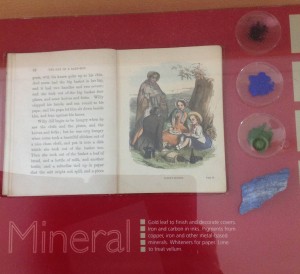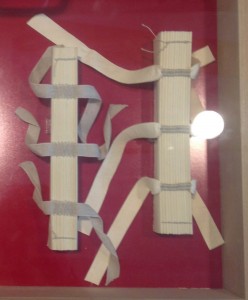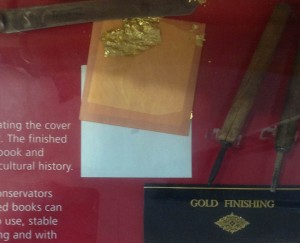When it comes to the conservation of print, most people’s minds immediately jump towards thoughts of ancient texts being carefully handled and re-purposed, or to dark, moisture-free areas in subterranean libraries full of old books too delicate to see the light of day. Well, the conservation of ancient books, scrolls and manuscripts is a very important and painstaking process, but have you ever thought about the conservation of material printed today?
Seeing as we’re all living in the here and now, thoughts about conserving the present don’t usually come around too frequently. We’re always concerned about preserving the past and ensuring that great artifacts of the past 200 or so years don’t end up in the garbage. But what we fail to think about is the stark reality that we need to preserve our present for the future as well. In fifty years, how are new generations going to know anything about the early 21st century? Well, lucky for us, there are people out there who are most certainly concerned with preserving our day and age for the future.
A great place to start with modern-day conservation techniques is the Library of Congress. Not only does the Library of Congress house 32 million cataloged books, 61 million manuscripts, the largest rare book collection in North America (including a rough draft of the Declaration of Independence), 6,000 comic books and 6 million works of sheet music but it also houses 1 million issues of world newspapers that span the last three centuries. Because newspapers are a primary source for local news on a daily basis throughout the world, they’re one of the best resources available for preserving current history. How then, does one store a million issues of world newspapers? Not in grandma’s basement, that’s for sure.
Thanks to the United States Newspaper Program, thousands of newspapers are located, collected and placed on microfilm so our posterity can always, always, remember the exact date on which Lindsay Lohan went to jail for the 17th time. Shocking as it may be, even papers like The National Enquirer get placed in the secure vault of newspapers located at the Library of Congress. Small local papers, the New York Times, and issues of Cosmopolitan magazine all get placed on microfilm and stored securely for the future. The Library of Congress doesn’t seem to spare any publication, considering all print to be a historical document.
The next logical question to ask is: how exactly does one place thousands of newspapers on microfilm? Well, in so many words, a preservationist takes a photograph of every single page of a newspaper and then puts the film safely in an air-tight box with all of the other film reels. It’s a simple process, which is why it can be done to so many publications.
The only issue with microfilm preservation is that it’s difficult to access at a later time. Luckily for the world, the Library of Congress thought of this issue as well and has worked on placing all microfilm versions of papers onto CD’s and other types of digital media. Now, one can easily access thousands of newspapers through digital means at the Library of Congress. It’s quite incredible that thousands of pages a day are being recorded and stored digitally. However, is it possible that these digital files storing books, newspapers, magazines and other preserved media could someday crumble like the pages of an ancient manuscript? How many times have you deleted a photo on your phone only to want it back five minutes later? Ever tried to open a Microsoft Word document only to discover the file cannot be opened for some unknown and obsolete reason? Somehow, things happen to files. We lose digital images; we accidentally delete important documents and can never seem to get them back. This is why we have backups and protect our digital files from corruption. Of course, it’s easier to backup your laptop to an external hard drive than say, backup 1 million newspaper and media files. Fortunately, the Library of Congress is well prepared for this type of issue, and protects its files from corruption. The main issue the Library will have is the continuance of this painstaking process. Many people work to accomplish the preservation of media documents from today’s culture, just like many work to preserve the past as well.
I recently visited the conservation department at the British Library and learned all about the demanding process of book and parchment conservation. As opposed to digital conservation, where workers hunch over computers and digital devices to ensure everything is up to par, a paper conservationist relies on skills of the original trade itself. Instead of studying computer science, a conservationist may study painting or book making, and must know a good deal of chemistry due to the high use of chemicals in preserving delicate pages and natural materials..
Books are made of natural materials, and natural materials have a tendency to wear down. A conservationist must ensure that when repairing an old text he doesn’t upset the delicate composition of the materials he’s working with. You can’t simply repaint over an illumination with acrylic paint. You have to determine what material the original creator utilized and use materials of a similar nature (this is where the chemistry comes in handy). Acrylic paint wasn’t too popular in the 7th century, so brightly colored minerals, egg, and water were typically mixed together to form paint. Gold leaf was a popular touch in many manuscripts as well, and this gold must be treated carefully so it doesn’t flake off ancient documents.

In viewing the materials used to repair books, I saw an extensive amount of natural resources. Cords of linen and hemp are (and were) used to sew the pages of books, and leather is obviously employed for binding as well. A conservationist’s tools are quite simple, just like the ones original bookmakers would employ. Scalpels, spatulas, needles, bindings, scrapes and small hammers are common tools utilized by conservationists and bookmakers alike.

It can take months and sometimes even years to repair one text to its original state, and many conservationists simply attempt to elongate the lifespan of a text as opposed to restoring it. Some texts are simply too fragile too fully restore, and therefore preservation rather than restoration is key.
The difference between conservation of the past and present is astonishing. Repairing burnt, weathered and damaged texts is a hands-on, painstaking process that takes hundreds of hours. Conservation of digital files is a more general process, involving the protection of files and difficult collection of the files one wants to conserve (there are just so many newspapers out there!). Digital conservation isn’t a walk in the park though, as it is a constant, daily process just to keep up with the rate the world is progressing at.
Fortunately, there are many people who believe conservation of both past and present is extremely important, and are dedicated to ensuring our past and present are preserved for many years to come.
Go visit these sites for more information on conservation:
Library of Congress Newspaper Conservation

